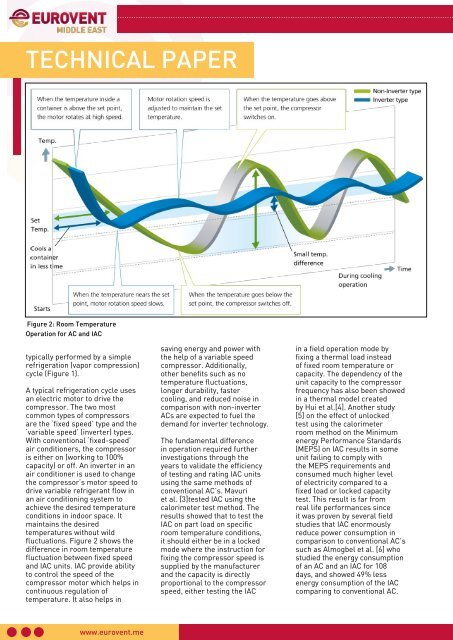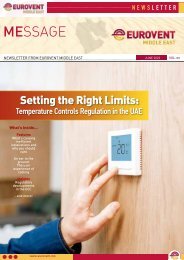EME Newsletter MEssage #1/2022
HVACR Industry news from Eurovent Middle East
HVACR Industry news from Eurovent Middle East
You also want an ePaper? Increase the reach of your titles
YUMPU automatically turns print PDFs into web optimized ePapers that Google loves.
NEWSLETTER<br />
TECHNICAL PAPER<br />
Figure 3: Calorimeter room method<br />
schematic<br />
Figure 4: Enthalpy difference method schematic<br />
Figure 2: Room Temperature<br />
Operation for AC and IAC<br />
typically performed by a simple<br />
refrigeration (vapor compression)<br />
cycle (Figure 1).<br />
A typical refrigeration cycle uses<br />
an electric motor to drive the<br />
compressor. The two most<br />
common types of compressors<br />
are the ‘fixed speed’ type and the<br />
‘variable speed’ (inverter) types.<br />
With conventional ‘fixed-speed’<br />
air conditioners, the compressor<br />
is either on (working to 100%<br />
capacity) or off. An inverter in an<br />
air conditioner is used to change<br />
the compressor’s motor speed to<br />
drive variable refrigerant flow in<br />
an air conditioning system to<br />
achieve the desired temperature<br />
conditions in indoor space. It<br />
maintains the desired<br />
temperatures without wild<br />
fluctuations. Figure 2 shows the<br />
difference in room temperature<br />
fluctuation between fixed speed<br />
and IAC units. IAC provide ability<br />
to control the speed of the<br />
compressor motor which helps in<br />
continuous regulation of<br />
temperature. It also helps in<br />
saving energy and power with<br />
the help of a variable speed<br />
compressor. Additionally,<br />
other benefits such as no<br />
temperature fluctuations,<br />
longer durability, faster<br />
cooling, and reduced noise in<br />
comparison with non-inverter<br />
ACs are expected to fuel the<br />
demand for inverter technology.<br />
The fundamental difference<br />
in operation required further<br />
investigations through the<br />
years to validate the efficiency<br />
of testing and rating IAC units<br />
using the same methods of<br />
conventional AC’s. Mavuri<br />
et al. [3]tested IAC using the<br />
calorimeter test method. The<br />
results showed that to test the<br />
IAC on part load on specific<br />
room temperature conditions,<br />
it should either be in a locked<br />
mode where the instruction for<br />
fixing the compressor speed is<br />
supplied by the manufacturer<br />
and the capacity is directly<br />
proportional to the compressor<br />
speed, either testing the IAC<br />
in a field operation mode by<br />
fixing a thermal load instead<br />
of fixed room temperature or<br />
capacity. The dependency of the<br />
unit capacity to the compressor<br />
frequency has also been showed<br />
in a thermal model created<br />
by Hui et al.[4]. Another study<br />
[5] on the effect of unlocked<br />
test using the calorimeter<br />
room method on the Minimum<br />
energy Performance Standards<br />
(MEPS) on IAC results in some<br />
unit failing to comply with<br />
the MEPS requirements and<br />
consumed much higher level<br />
of electricity compared to a<br />
fixed load or locked capacity<br />
test. This result is far from<br />
real life performances since<br />
it was proven by several field<br />
studies that IAC enormously<br />
reduce power consumption in<br />
comparison to conventional AC’s<br />
such as Almogbel et al. [6] who<br />
studied the energy consumption<br />
of an AC and an IAC for 108<br />
days, and showed 49% less<br />
energy consumption of the IAC<br />
comparing to conventional AC.<br />
Despite clear scientific evidence<br />
of the difference in operation<br />
of the conventional AC and IAC,<br />
there is no definitive solution<br />
in the international regulation to<br />
differentiate the testing<br />
procedure of these two types<br />
of units. This article presents the<br />
adopted solutions of the<br />
regulation’s commissions in<br />
different countries and the<br />
feedback and experience of<br />
Eurovent Certita Certification<br />
(ECC) body for this matter.<br />
Inverter Air-Conditioner Testing<br />
schemes<br />
For a variety of HVAC equipment,<br />
many testing methods have been<br />
developed. Heating balance<br />
method (calorimeter room<br />
method) and enthalpy difference<br />
method are commonly used for<br />
testing HVAC equipment.<br />
Calorimeter Room (Figure 3) test<br />
heat balance test device<br />
is a room air conditioning<br />
performance test device. The<br />
method of calibrating the<br />
performance of air conditioner<br />
with calorimeter test bench<br />
is called Room heat balance<br />
method. The basic principle is<br />
based on the law of conservation<br />
of thermodynamics (the first law<br />
of thermodynamics): that is<br />
Input Energy = Output Energy<br />
The air enthalpy difference<br />
method (Figure 4) is a way<br />
to test the performance<br />
of the air conditioner by<br />
measuring the enthalpy and<br />
the circulating air volume<br />
of the air at the inlet and<br />
outlet of the air conditioner.<br />
It consists of measuring the<br />
enthalpy difference of the<br />
inlet and outlet air inside the<br />
air conditioner chamber and<br />
calculate the air conditioner<br />
capacity through the heat<br />
exchanger air flow. The<br />
enthalpy is measured by<br />
measuring the temperatures<br />
of dry and wet bulbs (T-Ts<br />
method).<br />
When testing the IAC freely<br />
without setting the parameters<br />
from the manufacturer, the<br />
capacity of the unit would not<br />
be constant even if the ambient<br />
temperature is constant.<br />
The internal control of the<br />
unit will compensate for the<br />
thermal load of the room.<br />
The IAC unit will be checking<br />
the air temperature from<br />
time to time using its own<br />
censor and will adapt with the<br />
capacity being delivered to<br />
compensate the thermal load.<br />
If the unit determine that the<br />
temperature is going down in<br />
a cooling capacity test then<br />
the unit will realize that the<br />
capacity delivered is too much<br />
and it will reduce the capacity<br />
by reducing the compressor<br />
frequency. On the opposite<br />
side, if the ambient conditions<br />
are going up, then the unit<br />
would increase the capacity<br />
by increasing the compressor<br />
frequency and the fan speed and<br />
the electronic expansion valve<br />
on both sides of the unit. During<br />
the test of IAC, to maintain the<br />
unit on a fixed capacity, the<br />
operational parameters of the<br />
unit should be fixed (compressor<br />
frequency, electronic expansion<br />
valve and the fan speed).<br />
As one can see from how both<br />
testing methods function, the<br />
IAC with a variable capacity<br />
could not be tested using the<br />
calorimeter room method and<br />
is too difficult to test using the<br />
air enthalpy method. Therefore,<br />
in the current state of available<br />
technology, testing an IAC<br />
should require setting fixed<br />
parameters such as compressor<br />
speed and frequency and in<br />
some cases fan speed and the<br />
expansion valve opening. This<br />
could be done by manually<br />
involving a thermostat included<br />
in the unit or automatically<br />
with a preset parameters in<br />
what is called testing mode.<br />
This procedure aims to convert<br />
the IAC unit into a fixed speed<br />
compressor unit for testing<br />
purpose.<br />
www.eurovent.me MAY <strong>2022</strong> VOL. 01











